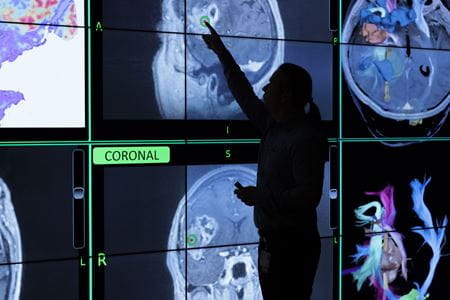INDIANAPOLIS — A new Indiana University School of Medicine-led study, featuring the contributions of dozens of international scientists, offers a new model to evaluate the real-world performance of artificial intelligence in international settings and examined AI's effectiveness at identifying the boundaries of the deadliest brain tumor. The team of scientists also discussed the best way to use this technology going forward, considering factors such as accuracy and patient privacy.
Their research, published recently in Nature Communications and featured by Nature in the Editors' Highlights, studied federated learning, a way of training and validating AI models across institutions without the need to share patient data.
"AI can help physicians diagnose tumors that are almost invisible to the naked eye," said Spyridon Bakas, PhD, senior corresponding author of the article, an associate professor and computational pathology division chief in the IU School of Medicine's Department of Pathology and Laboratory Medicine, and a researcher within the IU Melvin and Bren Simon Comprehensive Cancer Center. "AI models trained with federated learning have seen and gained knowledge from an abundance of data that is infeasible for a single institution to acquire or individual physicians to assess."
While centralized hospital data often contains only a limited scope of past cases, AI models trained under a federated learning model can almost immediately compare scans from all over the world.
The team analyzed the Federated Tumor Segmentation challenge, the first large-scale benchmark for brain tumor segmentation.
The AI models attempted to identify the boundary of glioblastomas in radiology scans. People afflicted with these aggressive tumors have a median survival rate of about 14 months, with less than 7% of people surviving more than five years, the study noted.
Glioblastomas are particularly difficult to quantify, Bakas said. The AI algorithms used in the study focus on detecting the boundaries of each tumor in special brain scans.
In all, 41 models were trained and deployed on cases from 32 sites across six continents. Most of these tests yielded positive results in identifying tumors.
Federated learning challenges, once put into wider practice with more available data, will ultimately lead to better treatment outcomes in patients — even in rare disease cases, Bakas said.
"Our key takeaway is that large, federated, multi-site benchmarking is essential to validate AI in health care and to advance clinical readiness," said Prashant Shah, MS, chief technology officer of federated AI and confidential computing at Intel Corp. and a co-author of the study.
More than 100 authors contributed to the study. It was conceived by Bakas, Ujjwal Baid, Sarthak Pati and Akis Linardos of the IU School of Medicine, as well as Maximilian Zenk and Klaus Maier-Hein of the German Cancer Research Center Heidelberg. Bakas and Maier-Hein jointly supervised the work.
The research was funded by a series of grants from a variety of sources and countries, including several National Institutes of Health grants awarded to Bakas.
About the Indiana University School of Medicine
The IU School of Medicine is the largest medical school in the U.S. and is annually ranked among the top medical schools in the nation by U.S. News & World Report. The school offers high-quality medical education, access to leading medical research and rich campus life in nine Indiana cities, including rural and urban locations consistently recognized for livability. According to the Blue Ridge Institute for Medical Research, the IU School of Medicine ranks No. 13 in 2024 National Institutes of Health funding among all public medical schools in the country.
Writer: Rory Appleton, rapplet@iu.edu
For more news, visit the IU School of Medicine Newsroom: medicine.iu.edu/news




